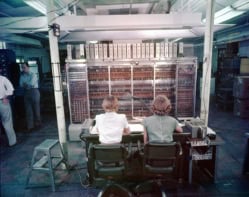By Matin Durrani
It’s time for me to bow out of the LT25 low-temperature conference here in Amsterdam, which has just ended. The cool crowd will reconvene in three years’ time for LT26, which, I can reveal, will take place in Beijing, at a venue next to the current Olympic park. It’ll be the first time that China will host this triennial shindig.
Conference organiser Peter Kes from the University of Leiden gave some amusing insights into organising a conference of this scale, which saw a staggering 1482 participants. For example, stuffing the massive 380-page (double-sided) conference brochure into delegates’ shoulder bags required a small army of students, who hit a peak rate of 450 bags stuffed per hour.
Then there were the logistics of bussing 640 delegates on a trip to the University of Leiden to see the lab where Heike Kamerlingh Onnes won the race against Scottish physicist James Dewar to liquefy helium 100 years ago last month. Plus sorting out the conference dinner for nearing 600 people, which included hiring a flotilla of nine boats for the trip from the conference halls into town.
As for the physics, my head is spinning from the final day’s plenary lectures, which featured Nobel laureate Wolfgang Ketterle talking about superfluidity in a gas of strongly interacting fermions, Subir Sachdev explaining how black holes can link quantum phase transitions with hydrodynamics, and Eberhard Gross showing how “density functional theory” allows the temperatures at which certain materials superconduct to be calculate from first principles.
The session also included a few words from Joe Vinen from the University of Birmingham in the UK — perhaps the only surviving physicist from the LT6 conference in Leiden 50 years ago. Vinen recalled how the multi-talented Richard Feynman himself actually put in an appearance at the Leiden meeting to present his insights into superfluidity in liquid helium. Strangely, though, Feynman failed to show up at any other sessions. The reason? The bongo-playing womaniser had chosen to enjoy the pleasures of what used to be called (in the bad old days) the conference “ladies programme”.
In fact, Vinen was also present at the LT2 meeting in Oxford in 1951, when lectures were given on blackboards that physicists could barely make out through a fog of cigarette smoke. Indeed, he recalled how low-temperature pioneer Fritz London smoked so much that he was politely invited to remove his cigarette…at least while he was talking.
But apart from the switch to Powerpoint for lectures, I am sure that physicists of 50 years ago would very much feel at home at today’s conferences. They’re bigger of course — just 210 people showed up in Oxford — and almost everyone now has a laptop poking out of their shoulder bag. And no-one is even allowed to smoke in enclosed public spaces in Holland any more. But conferences are still one of the great perks of research, being essential for sharing information, meeting new people and, of course, having a good time.



